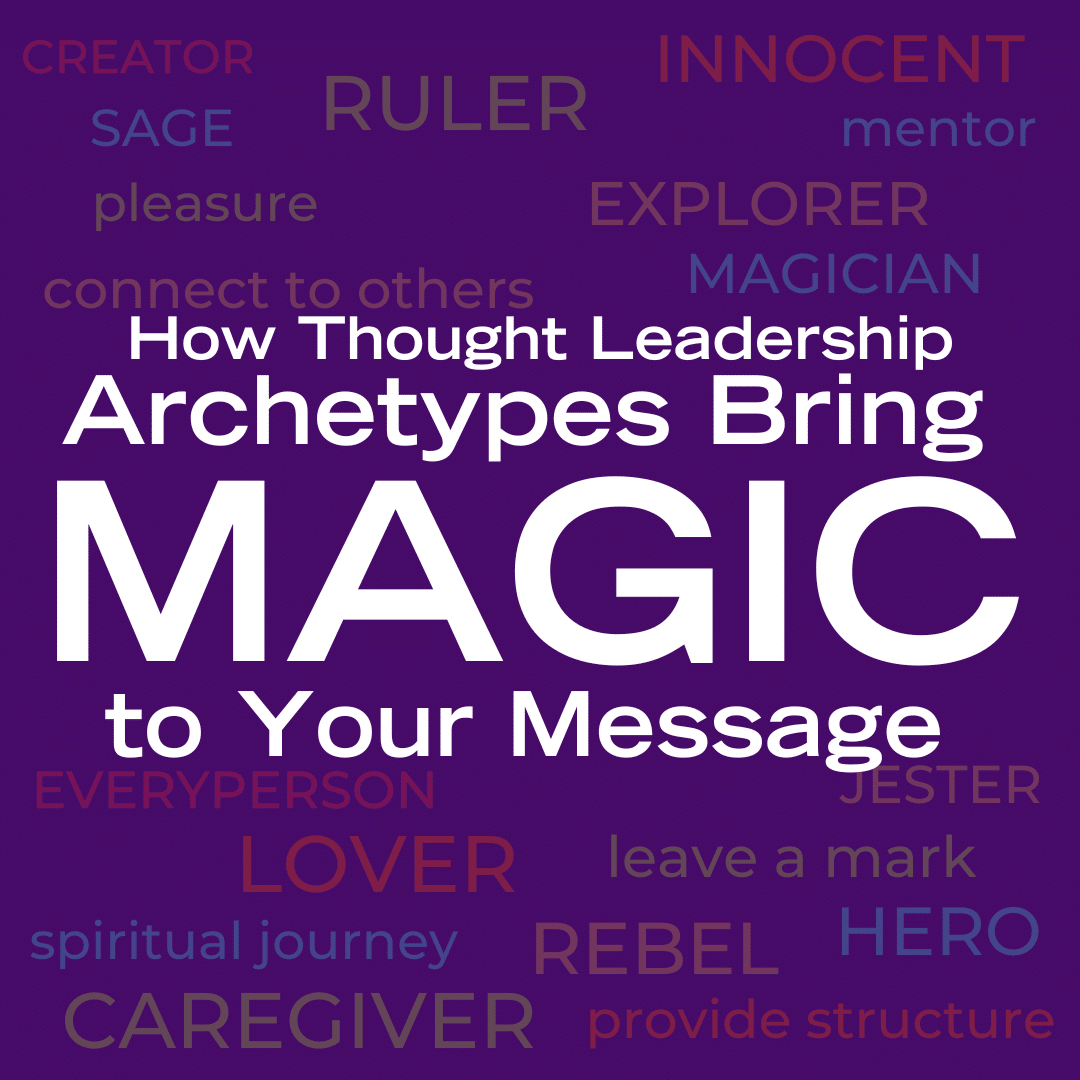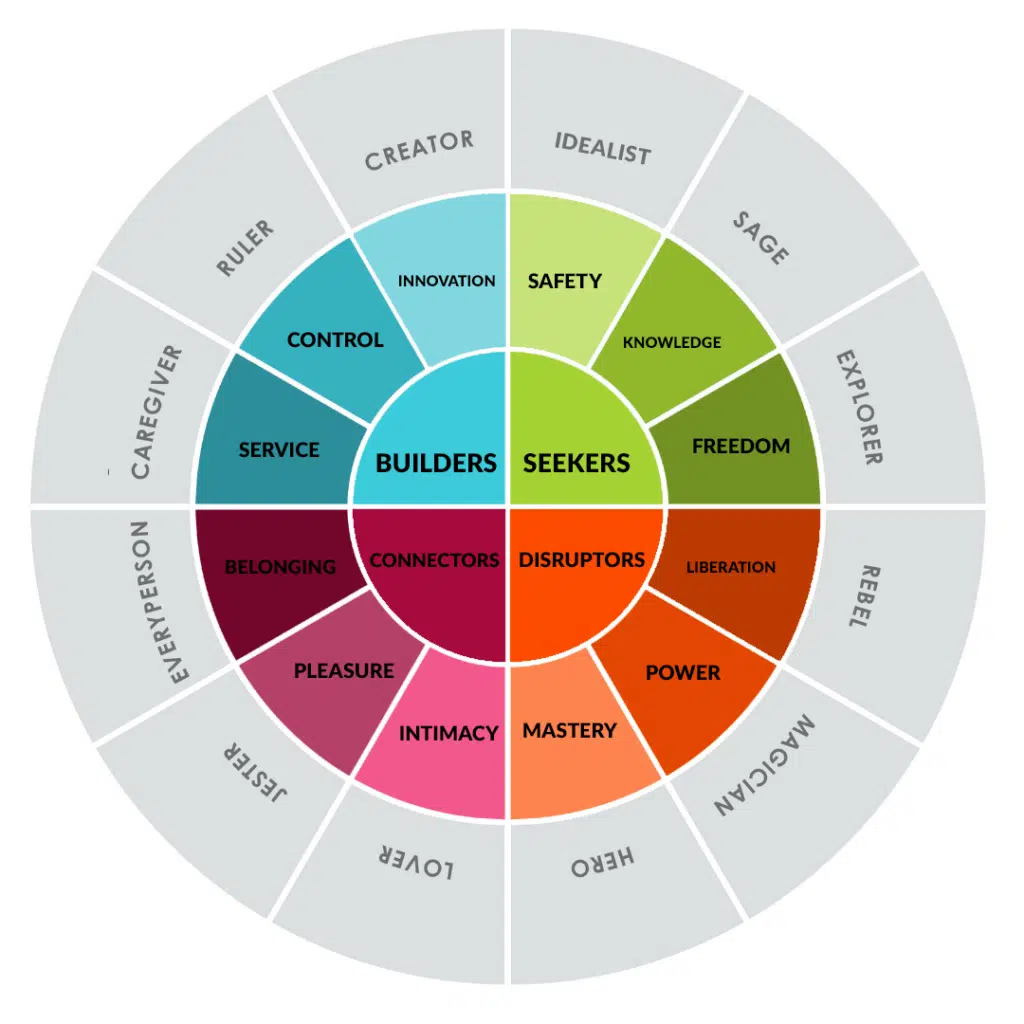
Blog, Leadership, Personal Development, Vocal Leadership
How Thought Leadership Archetypes Bring Magic to Your Message
We are all born with two voices: the one we speak with and the one that speaks to us inside. Our inner voice provides navigation through life, while our outer voice is the tool we use to guide, teach, influence, and help others. When our inner voice is aligned with our outer voice, true, authentic thought leadership comes forth.
While we can certainly argue the notion that we have many voices inside of us, (I’m the first person to admit that I have inner ‘board meetings’ sometimes with myself) the central premise here is that our communication becomes clear once we become more congruent and aligned with ourselves. We become more grounded and centered, and when we speak or write, that alignment comes through in all forms of our communication – vocal, physical, energetic, and in the words we choose.
You might have heard of Carl Jung’s 12 Archetypes, and how brands utilize them in marketing. According to Jung, the human psyche is predisposed to these archetypes and they are patterned into us inherently. Versions of these archetypes are found in storytelling across world cultures and through millenia.
We are always evolving our identity as thought leaders. By identifying our current primary and influencing archetypes, we give ourselves a space to check in with our inner and outer voices and ask ourselves:
- Is my voice and message consistent?
- Do my words and thoughts reflect what is authentic for me at this time?
- Does my message feel forced or awkward, or fluid and easy?
- Am I enjoying and excited about my own thought leadership, and the messages I’m putting out into the world?
Utilizing archetypes as a guide enriches our content development by giving a natural and psychologically congruent place to develop and express one’s communication style. In essence, when you communicate using your thought leadership archetypes as a guide, you are perceived as credible, trustworthy, and authentic.
Read on with a curious mind and discover the magic of thought leadership archetypes.

The Seekers: Innocent, Explorer, Sage
While there are 12 archetypes, each fall into a quadrant of similarity. The Seekers are a quadrant defined by a need for knowledge, freedom, and safety.
The Innocent is well known for their optimism. They have the ability to comfort others through their “glass half full” mentality. Innocents can simplify complex topics easily, recognize opportunities others may not see, and bring forth an inspirational perspective that carries a team through tough times. While they may be perceived as naive or in denial, the Innocent’s deep faith and trust in life keep them going.
The Explorer is the Indiana Jones of the workplace. Always looking to embark on the next adventure, the Explorer centers their thought leadership around the potential of unexplored avenues of inquiry, divergent thinking, and asking great questions that can lead to innovation. Explorers value autonomy and freedom over all else, which may lead them to feel trapped and easily bored.
The Sage is your quintessential thought leader. Sages are perceived as experts in a wide range of topics due to their love for learning, and therefore make excellent mentors, educators, and coaches. While they may not be the most charismatic, their ability to think critically and analyze data allows Sages to enjoy a high level of credibility amongst their colleagues and followers.
The Disruptors: Hero, Rebel, Magician
The Disruptors are those who leave a mark. They are courageous, provocative, and dynamic people who value liberation, power, and mastery.
The Hero inspires others with their stories of overcoming the odds and rising to challenges. They thrive in a competitive environment with a clear set of goals, and take pride in their dedication to their cause. However, this need to succeed may cause Heroes to disregard their personal wellbeing, as their strength comes not from themselves but who they are in the world.
The Rebel has the courage to challenge the status quo. A positive advocate for change, Rebels are admired for their ability to speak out against inefficient systems and comfortably live in the uncomfortable. Their high tolerance for risk allows them to throw out the old in favor of the new, even if their recklessness comes at a high price.
The Magician is a charismatic miracle-worker. They use their charm and creative intuition to bring the seemingly impossible into fruition, because Magicians love to make dreams come true. Their spot-on hunches and ability to influence their adversaries may cause others to doubt the credibility of Magicians. In the face of disbelief, Magicians return to themselves and spiritual guidance to carry on.
The Builders: Creator, Ruler, Caregiver
The Builders provide structure in an increasingly noisy world. They are creative, compassionate, and confident.
The Creator is powered by imagination. Their ability to see the final product in the raw material is what allows them to foster innovation and self-expression. Creators take an artful and individual approach to creative thinking and problem solving that motivates others to stretch themselves and see the creative solution. Like most artists and entrepreneurs, Creators have a flair for the dramatics and are prone to perfectionism in everything they do.
The Ruler is a natural-born leader who knows how to use power. They prefer to lead from within, utilizing their social organization prowess and networking skills to improve the world. They may be seen as domineering and tyrannical, but Rulers know when they should intervene with structure, rules, and decisions.
The Caregivers’ superpower is their empathy. Caregivers notice when others need help and support. They naturally foster peaceful and harmonious environments where all feel welcome and safe. While they tend to have poor boundaries, the Caregivers use their keen social intelligence to be the “glue” holding everything together.
The Connectors: Everyperson, Lover, Jester
The last quadrant of archetypes is the Connector. These are people who excel at connecting meaningfully with others in a fair, passionate, and funny way.
The Everyperson is a leader that’s hard to spot. They prefer to fit in with the crowd and be relatable, yet still inspire, advocate, and foster others like any other archetype does. This unique take on leadership comes from their steadfast belief in the equality of every person. They are loyal to humanity to a fault, and their realist approach to life may be mistaken as pessimism.
The Lover seeks real connection in their life. With their charismatic, engaging, and beautiful personalities, Lovers excel at creating lasting relationships that are meaningful and abundant. They know how to incorporate the romantic, the cherished, and the intimate into their personal branding from wearing their heart on their sleeves their whole lives.
And finally, The Jester is proof that life is but a stage. Jesters know how to effectively use humor and performance to promote change. They encourage others to laugh rather than cry and foster high morale amongst their team, effortlessly creating an environment where people want to work. Jesters put the fun back into boring presentations, meetings or brainstorming sessions, as long as they stay away from mean-spirited or self-indulgent jokes.
We are each a blend of archetypes to varying degrees. Sometimes connecting to a different archetype than our primary is just what you need to spice up your thought leadership. Which archetype, or blend of archetypes, do you resonate with the most?
At Twin Flames Studios, we’re developing a more powerful assessment (releasing later this year) to support you, your voice, and messaging of your thought leadership archetypes.
If you don’t want to wait to discover more about using your Thought Leadership Archetypes, meet with us to discuss how we can deepen your presence and grow your business and message with your voice.
Inspired to turn your Voice into influence and become a Thought Leader worth listening to?
Let's Talk

Create a Professional and Profitable Audiobook!
The Insiders Guide to Audiobook Production gives you the inside track to create a high-quality and effective audiobook and reach a much larger new audience.
Thank you!
Please check your inbox for your email.
If you don't see anything in a few minutes, please check your spam folder.

Leave a Reply